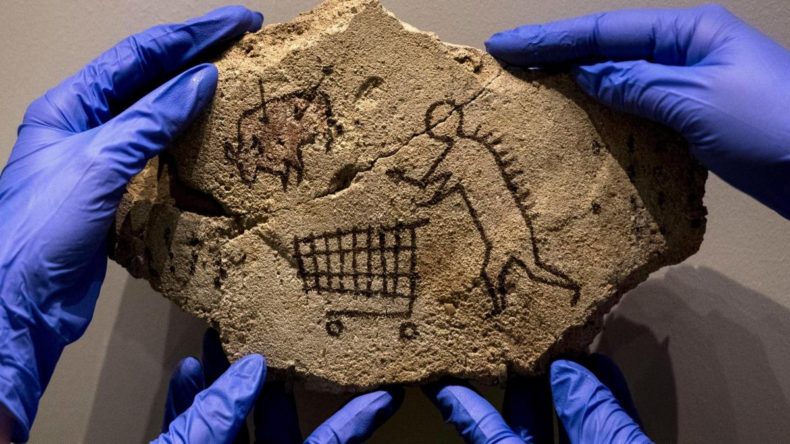
A former in-law came online a few days back to call me a troglodyte, and then a caveman. And not a nice way. I’m not averse to the title. I am a bearded, trunky fellow, strong legs and back. I can carry much weight through high passes and rocky canyons. I can’t recall the number of caves I’ve slept in; there’ve been many. I’ve got caveman cred.
Imagine Homo heidelbergensis hunkered at the mouth of a natural rock shelter 700,000 years ago, pondering how to feed his children, or a Neanderthal thumbing out flower petals over the grave of a dead relative, dusting it with pollens, laying down pieces of ochre. We all have deeply rooted ancestry somewhere in the world.
Maybe she was thinking more recently, the Wisconsin Ice Age, late Pleistocene. I’d be from a clan of cave painters and valley dwellers, people working mammoth ivory into eyed sewing needles for their clothes. By the Last Glacial Maximum 20,000 years ago, Homo sapiens was the last tool-making hominid on earth, anatomically modern, brains 5 percent larger than our own. For what that’s worth.
Is this the caveman she meant? An atlatl thrower, ground sloth eater? Using fox canines, I might have strung ornaments around my neck, scavenged mammoth kills on the tundra, burned bone to make fire. These were people with languages and customs. Venus figurines had already been made for tens of thousands of years. Trade routes extended hundreds of miles, sometimes thousands. Though it would be 15,000 years before metal, we did more or less what we do today: forage, sleep, eat, talk, worry, hope.
I do prefer sleeping on the ground. Tents should only be for adverse weather, or flying, biting insects. It’s best to sleep out, face to the open air. People ask me, a desert caveman, about rattlesnakes, scorpions, and black widow spiders. I say I haven’t had a problem yet. I try to keep good relations with such creatures.
I’ve taken refuge in many caves and natural shelters over the decades, clearing a space for my shoulders in blowsand, brushing away twigs or bones left by woodrats. I’ve watched snowstorms and fearsome battles of lightning from within stone enclosures, the sky reduced to a mouth or a crack. Some nights, the openings have been soaring, magnifying every snap of twig or rustle in the leaves.
Three times I’ve been bitten by kissing bugs, who live in caves where other animals sleep. They suck your blood until they are as plump as jelly beans.
She could have meant that I don’t work as well as a person should in civilization, thinking at a different pace. I smell like woodsmoke when I should smell like hair product. I take my children on walks, find tracks, drink from water holes, when they ought to be in school. I am puzzled by crosswalks and cell phones. I stare at the sky.
She might have been referring to an older form, earlier hominid, maybe prior to upright walkers, before footprints were left from an Australopithecus afarensis family crossing volcanic ash in East Africa three and a half million years ago. She might have had me in the trees in her mind, a screeching vine-crawler, shit-slinger. But she spelled out caveman and troglodyte. That’s more specific.
I go back to H. heidelbergensis, thought to have been a heavy-browed grunter with a handful of useful words, a lot of gestures, hand movements, reading each other’s faces. That’s probably more what she was thinking. I’d be cutting meat with a stone blade, the meat bit between my teeth and stretched with one hand. If the meat tore too suddenly, I might have nicked a front tooth with the blade. Anthropologists have found exactly this in our buried remains.
She must have pictured a chip-tooth goon living in his own drying feces at the mouth of a cave. The cave, until now, had been occupied only by dire wolves, giant bears, and cats the size of grizzlies. It was 700,000 years ago and this species in northern Spain was the first to take this giant predator’s cave, the view unparalleled, protected by the dark eye of a limestone enclosure where we looked across a valley filled with animals, big, wooly meat. At night we slept safely, protected by the rock around us.
Yes, I think this is what she meant.
Photo: Banksy art found in the British Museum The Sunday Times
Loved this article, Craig, but I need an update. I thought our species WAS homo sapiens. What’s the academic term for our species now? By the way, doesn’t the name ‘Craig’ mean rock or something like that? It fits … nicely.
Name-calling: an amazing human tactic. Label someone you don’t understand or have a problem with and it reduces their entire being to a single feature. Then you can deal with them by writing them off.
At least she didn’t call you a poo-poo head
Last I checked, we are still Homo sapiens, though poo-poo heads should be in the running.
I would take the Caveman & Troglodyte labels as badges of honor. You are a first class Caveman!